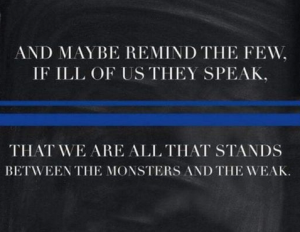Blue ribbons and point of view
If I’ve noticed anything in talking current events with people from around the country this past year, it’s that sometimes, two people can hear the same speech or read about the same incident and come away with completely different perspectives on what was said or what happened. That was an idea I knew I wanted to explore in BREAKOUT.
When our real-life Northern New York prison break manhunt was underway, people reacted in lots of different ways – with fear and anxiety, with shows of support for the searchers, and in some cases, with a new apprehension about anyone who seemed different. I paid attention to all of that and thought about how people from different backgrounds might view things like a blue ribbon tied on a tree as a show of support for law enforcement…

…or a request to deliver snacks and bottled water for police manning roadblocks.

How might those public shows of support be seen by a kid like Elidee, the sister of a prison inmate, who came from a city neighborhood where community relations with law enforcement were tense?
How might she see this sign, which I saw posted on a lot of social media pages around the time of the prison break?

This one was especially interesting to me, because in a sense, it divides the entire population of a community into three categories: prison inmates (referred to as “monsters”), law enforcement (the “we” of the quote), and “the weak” (everybody else). I understood why relatives of corrections officers would love the saying, especially at a time when their loved ones were facing criticism, even as they put their lives on the line in the manhunt. But I also wondered how those signs might feel to the relatives of prison inmates. I ended up using this as one of the documents that different characters talk about in the book. I also included the top-secret “Operation Michigan,” which we’ll talk about tomorrow. Here’s your writing prompt for today:
Your assignment: Write for a few minutes, reflecting on the “monsters and the weak” quote. You can write from your own perspective, or take on the voice of a corrections officer, prison inmate, inmate’s relative, or civilian.
Thanks for joining me on this part of the Breakout writing-process journey! If you’d like to read the other posts in this series once they’re all posted, you can find them here.

Buy BREAKOUT now:
- IndieBound (find a local bookseller near you!)
- The Bookstore Plus, Lake Placid, NY
- Powells
- Barnes and Noble
- Amazon





Kate, I haven’t gotten to every post….but this one is really good and important. Perception of an event is a history in a nutshell. Well done on this!
Hi Kate,
I am looking forward to reading Breakout as I have with all of your books, especially The Seventh Wish. In our district we are struggling to understand and then teach point of view vs. perspective. We understand there is a relationship between these two terms, but they are different. Could you weigh in on how you see them? Your title talks about POV and yet your blog talks about perspective – certainly they connect, but how do we teach elementary kids about these two ideas? Thanks for any insights you can share as an author and English teacher. Deirdre
Hi Deirdre! I’m not Kate and I definitely don’t know her thoughts on the difference, if any, between POV and perspective (I’d also love to hear what she has to say). But as a writer myself, I hope it might be helpful if I share a few thoughts?
I think the foundational distinction I’d want elementary students to have is that a lot of events can be interpreted in multiple ways. Let’s say for example that there’s a car wreck and we want to know who was at fault. So we check the camera positioned directly above the intersection, looking down, which shows that a red sports car entered the intersection first and made it halfway across before a black SUV entered on the sports car’s right side and hit the sports car. Since the sports car was there first, we conclude that the SUV is at fault.
But then we check another camera that was positioned ten feet high looking at intersection from the corner that could see both cars approaching. What we see then is that the light for the sports car changed to red, so the sports car should have stopped and didn’t. The SUV had right of way, so the sports car is at fault.
We can interpret the crash these two different ways because the cameras recorded different facts: who was in the intersection first, and who had the right of way.
But what about events where the facts are the same? If I buy a dozen raisin muffins for your class and ask them if this muffin tastes good, the students all have the same facts and still might come to different conclusions; some might think raisin muffins taste delicious while others think raisins are gross. These different conclusions are (for lack of a better term) differences in opinion.
To bring this back to POV vs. perspective, I should first state that I don’t see the terms as having too much difference in real life *except* in the very specific narratological sense where I assume you’re making this distinction. In most instances we could say that the cameras and students all made their conclusions from different points of view or because they had different perspectives.
But when we’re analyzing stories (and usually *only* then), we use the term POV to mean specifically the narrative choice between 1st person (using I/my), 2nd person (using you/your), or 3rd person (he/she/they) narration. There are also all sorts of distinctions among these, such as plural narrators (1st person = we/our) and how “close” or omniscient the narration is in terms of access to the character thoughts. For example, a close 3rd person has access to the thoughts of the one main character but not any other characters (e.g. Harry Potter, where we see Harry’s feelings, but Dumbledore’s thoughts an plans remain a mystery unless he reveals them in dialogue or notes). On the other hand, 3rd person objective doesn’t access anyone’s thoughts (like a movie camera), while 3rd person omniscient accesses everyone’s thoughts.
In our examples above, the cameras themselves have an objective POV; an author writing about this collision for a story could describe in 3rd person what the camera saw without reference to the camera itself. But if your student wrote a story about eating a raisin muffin and said, “I hated this muffin because…” then that’s a first person point of view. Alternatively, the story could be written from a close 3rd person POV where we see events from the teacher’s perspective and get the teacher’s thoughts written as “she was so worried the students wouldn’t like raisin muffins” but don’t know what the students are thinking: “Her student Jacob said, ‘I hated this muffin’ but she didn’t know if that was true or not because he was smiling and had actually eaten TWO muffins!”
The word “perspective” generally wouldn’t be used to describe POV in this way, and as such, when analyzing stories, we generally just agree to not use POV to describe anything else. Therefore, in this same focus on literary analysis, “perspective” would then likely refer to the “color,” content, or tone of the character’s thoughts as related to interpretation (these thoughts could be either explicitly stated or implied).
For example, my personal perspective about the crash might be that the sports car was at fault, but the driver of the SUV always drove so aggressively and so fast that getting in an accident was inevitable; I might even be “cruel” and think that the SUV driver deserved the accident even though it wasn’t their fault! Meanwhile, your perspective might be that both drivers are so nice, and you can’t believe either of them got into an accident.
An omniscient 3rd person POV could get both our thoughts, but really ANY POV could get our thoughts through dialogue (but only omniscient 3rd person could let the reader know for sure if both of us are telling the whole truth and nothing but the truth).
In our usual day-to-day speak though, the venn diagram of meaning for these two terms is mostly overlapping in the middle, and these two opinions could both be described as differences of POV or differences of perspective.
In sum, I think they should learn that differences exist and that we make a distinction in these terms when we’re analyzing stories so that we can specifically talk about the narrative device of 3rd vs. 1st person POV etc. without getting confused what we mean. I hope that helps!